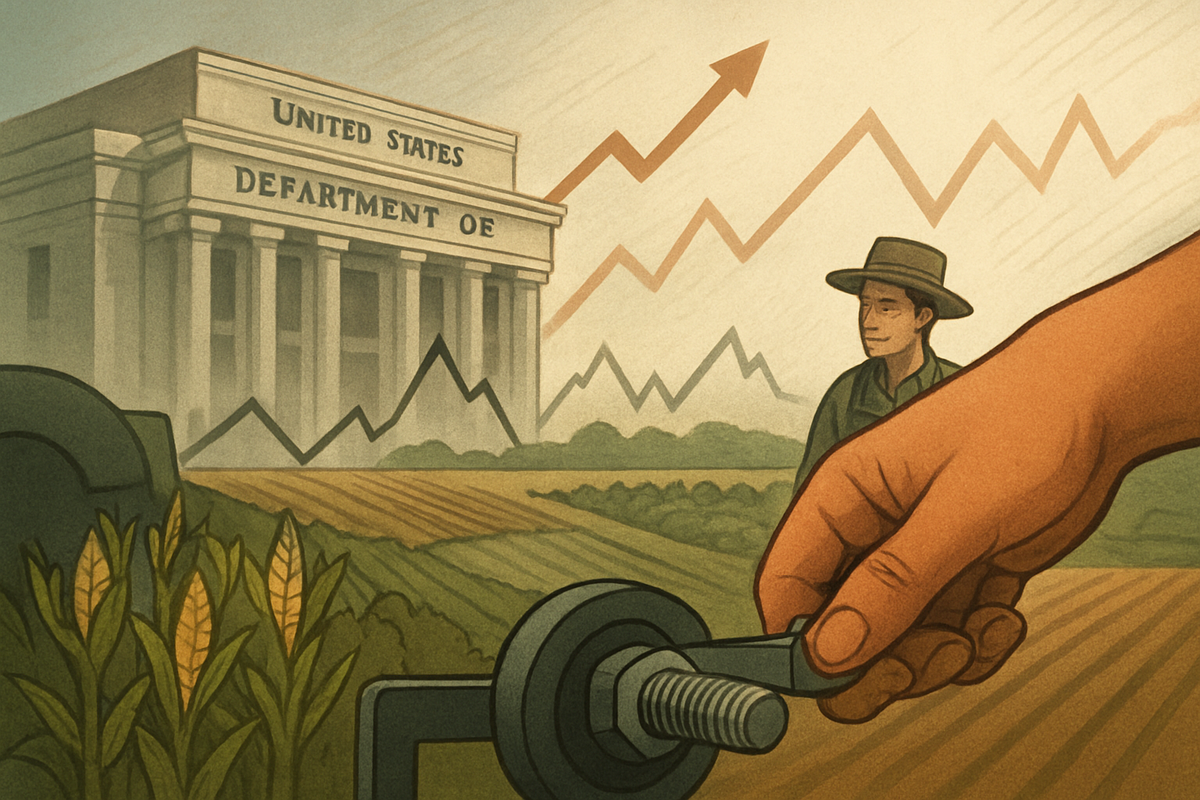
The U.S. Department of Agriculture (USDA) is currently facing significant pressure from a coalition of policy and taxpayer advocacy groups to implement stricter standards for its anticipated trade aid payments. This mounting scrutiny comes as the USDA prepares to disburse a new round of financial assistance to farmers grappling with ongoing economic challenges, trade disruptions, and high input costs. The core of the demand centers on enhancing financial accountability, increasing transparency, and preventing potential market distortions that critics argue have plagued previous aid programs.
The debate over these proposed changes carries immediate and substantial implications for agricultural commodity markets and producers across the nation. Farmers, already navigating thin margins and volatile global trade landscapes, face heightened uncertainty regarding the eligibility criteria and timing of future aid. Lenders, too, are monitoring the situation closely, as changes to aid standards could influence farmers' ability to secure crucial financing for upcoming planting seasons. The outcome of this pressure campaign will not only shape the distribution of billions in taxpayer dollars but also redefine the framework of government support for a vital sector of the American economy.
A Call for Accountability: Unpacking the Push for Tighter USDA Standards
The current push for stricter USDA trade aid payment standards is a direct response to concerns stemming from past programs and a broader call for fiscal responsibility. A diverse array of groups, including the R Street Institute, Farm Action Fund, Land Core, National Taxpayers Union, Soil & Climate Alliance, Taxpayers for Common Sense, and Taxpayers Protection Alliance, are at the forefront of this advocacy. While their perspectives on the necessity of farmer aid may vary, they are united in their demand for "commonsense financial accountability" in any future trade bailout.
This collective pressure has been building, fueled by a 2022 Government Accountability Office (GAO) review of the 2018-19 Market Facilitation Program (MFP), which identified significant issues with eligibility data and an estimated $800 million in improper payments. Critics argue that the MFP disproportionately benefited larger agribusinesses and absentee landowners rather than those truly in need. Consequently, the current demands include reducing waste and fraud, ensuring needs-based allocation using accurate economic data, and significantly enhancing transparency in payment distribution. There's also a strong call to strengthen the definition of "actively engaged" in farming, aiming to close loopholes that have allowed passive investors to receive payments.
On the other side, organizations such as the American Farm Bureau Federation (AFBF) and over 200 other farm groups emphasize the severe financial stress confronting farmers. They argue that economic assistance is vital to offset trade losses and provide a crucial bridge until improved safety nets, like those established by the "One Big Beautiful Bill Act," can fully take effect. This act, notably, increased per-year payment caps for farmers and eliminated income caps for certain entities, while also enhancing risk management tools. However, with the USDA projected to spend $35.2 billion in 2025 on supplemental and ad-hoc disaster assistance, taxpayer advocacy groups are increasingly concerned about the sustainability of such expenditures and their contribution to the national debt. Agricultural economists also voice concerns that excessive ad hoc aid could distort markets and contribute to high input prices for farmers.
The immediate market reaction to this ongoing debate has been one of increased uncertainty. While existing legislation and projected Agricultural Risk Coverage (ARC) and Price Loss Coverage (PLC) payments provide a baseline of support, the potential for delayed or more stringently conditioned new aid packages could impact farmers' financial planning for the upcoming planting season. Recent trade developments, such as China's commitment to increased soybean purchases, have offered some market buoyancy, particularly for soybean values, but the overarching question of how future trade aid will be structured remains a significant factor influencing farmer confidence and commodity market stability as of late November 2025.
Navigating the Shifting Sands: Companies on the Brink
The potential tightening of USDA trade aid standards introduces a complex dynamic for public companies operating within the agricultural sector, creating both winners and losers depending on their business model and reliance on farm profitability. The proposed changes, emphasizing stricter payment limits, income caps, and conditional aid based on risk management, aim to redirect support more effectively, but could inadvertently reshape the financial landscape for many.
Agricultural input suppliers, such as Corteva Agriscience (NYSE: CTVA), a major provider of seeds and crop protection, and Nutrien Ltd. (NYSE: NTR), a leading fertilizer and agricultural retail company, face potential headwinds. If stricter aid standards lead to reduced direct payments for farmers, particularly the larger operations that have historically received substantial aid, farmers might scale back on discretionary spending. This could translate to lower demand for premium seeds, advanced crop protection products, and new agricultural machinery from companies like Deere & Company (NYSE: DE). Consequently, these input suppliers could experience softened sales volumes and a direct impact on their top-line revenue and, subsequently, their stock performance. Investors might react negatively to anticipated reductions in farm profitability, leading to lower valuations for companies heavily reliant on sales to large-scale U.S. farms.
Conversely, while many large-scale farming operations are privately held, the implications for this segment are profound. These commercial farms have historically been major beneficiaries of farm subsidies, and stricter payment limits and income caps would likely reduce the direct aid they receive. This financial pressure could compel them to re-evaluate planting decisions, optimize input usage more aggressively, and seek greater efficiencies to maintain profitability amidst already thin margins and high input costs. The long-term effect could be an acceleration of the trend towards fewer, larger, and more industrialized operations, as smaller, less capitalized farms struggle to survive with reduced government support. Publicly traded agribusinesses with significant landholdings or integrated farming operations that relied on substantial direct payments could see their stock performance decline as investors price in reduced government support and increased financial risk.
Agricultural commodity traders, including giants like Archer Daniels Midland (NYSE: ADM) and Bunge Global SA (NYSE: BG), are likely to experience a more indirect impact. Their operations are primarily driven by global supply and demand dynamics, commodity price volatility, and international trade policies rather than direct U.S. farm aid. While a significant shift in U.S. agricultural output due to altered aid could indirectly affect the volumes and types of commodities available for trade, their core revenue streams are more sensitive to broader geopolitical events, global economic growth, and currency fluctuations. However, the USDA's continued focus on promoting U.S. agricultural exports and bolstering international food aid could provide a consistent demand channel for surplus commodities, offering a degree of stability for these traders. Ultimately, while the immediate ripples might be felt by farmers and their direct suppliers, the long-term impact on diversified global traders will likely depend on how these domestic policy shifts influence global agricultural trade flows and prices.
Beyond the Farm Gate: Wider Significance and Ripple Effects
The ongoing pressure on the USDA to tighten its trade aid standards represents a pivotal moment in American agricultural policy, extending far beyond individual farm balance sheets to touch upon broader industry trends, global trade relations, and the future structure of the U.S. farm safety net. This drive for "commonsense financial accountability" is deeply interwoven with critical issues like sustainability, farm consolidation, and the nation's standing in international trade.
The discussion around tighter aid standards subtly intersects with sustainability trends. While not explicitly mandating sustainable practices, the involvement of groups like the Soil & Climate Alliance in advocating for stricter criteria suggests a growing desire to integrate environmental considerations into agricultural policy. If future aid becomes more needs-based and potentially linked to risk management tools, there could be an indirect encouragement for farmers to adopt more environmentally conscientious practices, especially if such practices are factored into risk assessment or premium structures. This aligns with broader shifts towards more sustainable food systems and climate-resilient agriculture.
In terms of global trade, the implications are direct and significant. U.S. agriculture has historically relied on trade aid to offset losses from protectionist trade restrictions and retaliatory tariffs. However, the level of domestic support provided, especially when combined with other farm programs, raises concerns about the U.S. exceeding its "bound commitments" under World Trade Organization (WTO) agreements. Stricter, more transparent, and potentially less trade-distorting U.S. subsidies could reduce incentives for other agricultural exporting nations to challenge American farm programs, potentially fostering a more stable global trading environment. Conversely, if U.S. protectionist policies persist, countries like Brazil and Argentina could continue to capture market shares in commodities previously dominated by the U.S., exacerbating trade diversion effects.
The issue also ties directly into farm consolidation. The U.S. agricultural sector is under severe financial stress, characterized by persistent below-breakeven margins, eroded working capital, and a rise in Chapter 12 bankruptcies. Economists widely predict that this margin squeeze will accelerate farm consolidation. If trade aid standards are tightened and payments become more targeted or difficult to obtain, smaller, less diversified farms heavily reliant on such assistance may face increased financial pressure, potentially hastening their exit from the industry and contributing to further consolidation. While effectively targeted aid could theoretically slow consolidation for genuinely struggling smaller operations, the primary drivers appear to be broader market conditions and economic pressures.
From a regulatory and policy perspective, this debate will undoubtedly shape future farm bills. Calls for payment limits, income caps, and transparency are likely to become central themes in the next comprehensive agricultural legislation, potentially leading to a significant shift in direct programmatic expenditures. The current separate handling of traditional farm bill components, such as commodity programs and nutrition assistance (SNAP), has already strained the historical urban-rural coalition essential for passing comprehensive farm legislation, complicating future policy discussions. Internationally, future trade aid policies will face increased scrutiny to ensure they align with WTO commitments, particularly regarding "trade-distorting" subsidies, to avoid new disputes and uphold the U.S. goal of trade liberalization.
Historically, the U.S. has a long precedent of agricultural subsidies, dating back to the Great Depression's 1933 Agricultural Adjustment Act (AAA) aimed at stabilizing prices and production. While there have been attempts at reform, such as the 1996 "Freedom to Farm" Act, these have often been followed by a return to ad-hoc bailouts, illustrating the persistent challenge of balancing market forces with farmer support. The 2018-2019 Market Facilitation Program (MFP) serves as a direct and recent comparison, highlighting how large-scale, ad-hoc trade aid programs, while responsive to trade conflicts, can also generate substantial criticism regarding their design, transparency, and potential for improper payments—lessons that are clearly informing the current pressure on the USDA.
The Road Ahead: Navigating Future Scenarios and Strategic Shifts
The immediate and long-term trajectory of USDA trade aid standards is poised for significant evolution, demanding strategic pivots from producers and agricultural businesses alike. In the short term, Secretary of Agriculture Brooke Rollins has indicated that the USDA expects to announce a new aid package for farmers within weeks (as of late November 2025), potentially ranging from $12 billion to $15 billion. This package is being developed to address current economic pressures, including the lingering effects of tariffs, the absence of a new Farm Bill, and persistently high input costs. However, the "calculus" for domestic farmer assistance is reportedly shifting, influenced by recent major export commitments from key international markets like China, Southeast Asia, Pakistan, and Japan. Stronger export demand could potentially reduce the urgency and overall size of federal assistance programs, allowing market forces to provide a more organic boost to farm income.
Beyond immediate relief, the USDA has also launched the "America First Trade Promotion Program (AFTPP)" with a $285 million budget for 2026. This initiative aims to expand international market opportunities for American agricultural products, particularly in non-traditional markets, by identifying growth potential and addressing trade barriers. Major agricultural associations, including the American Soybean Association (ASA), have welcomed this program as a strategic opportunity to boost U.S. agricultural exports, signaling a potential long-term shift towards market development over direct subsidies.
In the long term, significant reforms to the agricultural industry's financial safety net are deemed necessary to enhance its resilience and responsiveness. With the current Agriculture Improvement Act of 2018 assumed to remain in effect through the 2033 projection period due to the delay in a new Farm Bill, future legislation will likely face renewed pressure to fundamentally reform the farm safety net. International trade rules, particularly those of the World Trade Organization (WTO), also loom large. Past U.S. trade aid packages have raised concerns about exceeding WTO domestic support limits, which could lead to trade dispute cases. This ongoing scrutiny could drive the USDA towards more WTO-compliant support mechanisms, potentially favoring decoupled payments or highly targeted, non-trade-distorting programs.
For producers and agricultural businesses, strategic adaptation will be paramount. This includes an intensified focus on robust risk management strategies beyond government aid, potentially increasing reliance on federal crop insurance or the Noninsured Disaster Assistance Program (NAP). Diversification of operations, exploring alternative crops or value-added products, and a more pragmatic, market-driven approach to planting decisions will be crucial to reduce reliance on specific commodities heavily impacted by trade disputes. Aggressive cost management and efficiency improvements will also be necessary to navigate high input costs and thin margins. Furthermore, actively engaging with new market development initiatives like the AFTPP and cultivating export relationships in non-traditional markets will be vital for long-term income stability and growth. Continued advocacy for pragmatic trade policies, visa reform to address labor shortages, and comprehensive, stable farm safety net legislation will also be essential.
Potential market opportunities include diversified export growth through programs like the AFTPP, increased demand from emerging markets, and the development of value-added agricultural products. Programs like Partnerships for Climate-Smart Commodities could also create market opportunities and premium prices for sustainably grown products. However, significant challenges persist, including ongoing U.S.-China trade tensions, the continued burden of high input costs, global supply chain disruptions, and critical labor shortages. There's also the risk that overly broad or untargeted ad hoc aid could distort markets and disincentivize participation in established risk management programs. The future will likely see a blend of conditional short-term relief, an increased focus on market access and diversification, and eventually, comprehensive Farm Bill reform, all while navigating the complexities of global trade and domestic economic pressures.
Charting the Course: A Comprehensive Wrap-Up
The pressure on the USDA to tighten trade aid standards marks a critical inflection point for American agriculture. The overarching takeaway is a clear and persistent call for "commonsense financial accountability," emphasizing needs-based payments, stricter eligibility, and enhanced transparency to rectify past program deficiencies and ensure taxpayer funds are utilized effectively. The agricultural sector, already under immense financial strain from low commodity prices and high input costs, faces a complex future where the nature and distribution of government support will be fundamentally re-evaluated.
Moving forward, the market will be shaped by a delicate balance between immediate government intervention and long-term strategic shifts. While an imminent aid package from the USDA is expected to provide some relief, the administration's stated long-term vision is to reduce agriculture's reliance on recurring government bailouts. This shift is being supported by renewed export commitments from key global partners and new initiatives like the America First Trade Promotion Program, which aims to diversify and expand international market opportunities for U.S. agricultural products. This suggests a gradual pivot towards a "trade, not aid" philosophy, encouraging a more market-oriented and resilient agricultural sector.
The lasting impact of this debate will likely be a more rigorous framework for federal assistance, potentially leading to comprehensive Farm Bill reform that institutionalizes stricter payment limits, income caps, and mandatory participation in risk management programs. Such changes, while requiring significant adaptation from producers, are crucial for fostering a more competitive and sustainable agricultural industry. Furthermore, the international scrutiny from the WTO regarding U.S. domestic support obligations underscores the global ramifications of these policy decisions, pushing the USDA towards more WTO-compliant support mechanisms.
Investors in the agricultural sector should remain vigilant in the coming months. Key areas to watch include the specific details of the upcoming USDA aid package, particularly its eligibility criteria and distribution methodology. The actual fulfillment of China's agricultural purchase commitments will be a critical indicator for commodity prices, especially for soybeans. Continuous monitoring of agricultural input costs, especially fertilizers, is essential, as these directly impact farm profitability. Furthermore, investors should track the evolution of new trade agreements, progress on Farm Bill reforms, and any reports from oversight bodies like the GAO regarding the effectiveness and financial integrity of aid programs. By carefully observing these dynamics, investors can better understand the shifting landscape of agricultural policy and market conditions, enabling more informed decision-making in this dynamic economy.
This content is intended for informational purposes only and is not financial advice


















